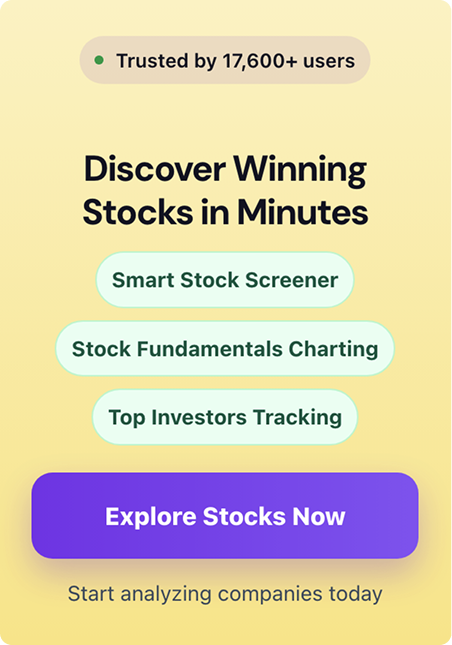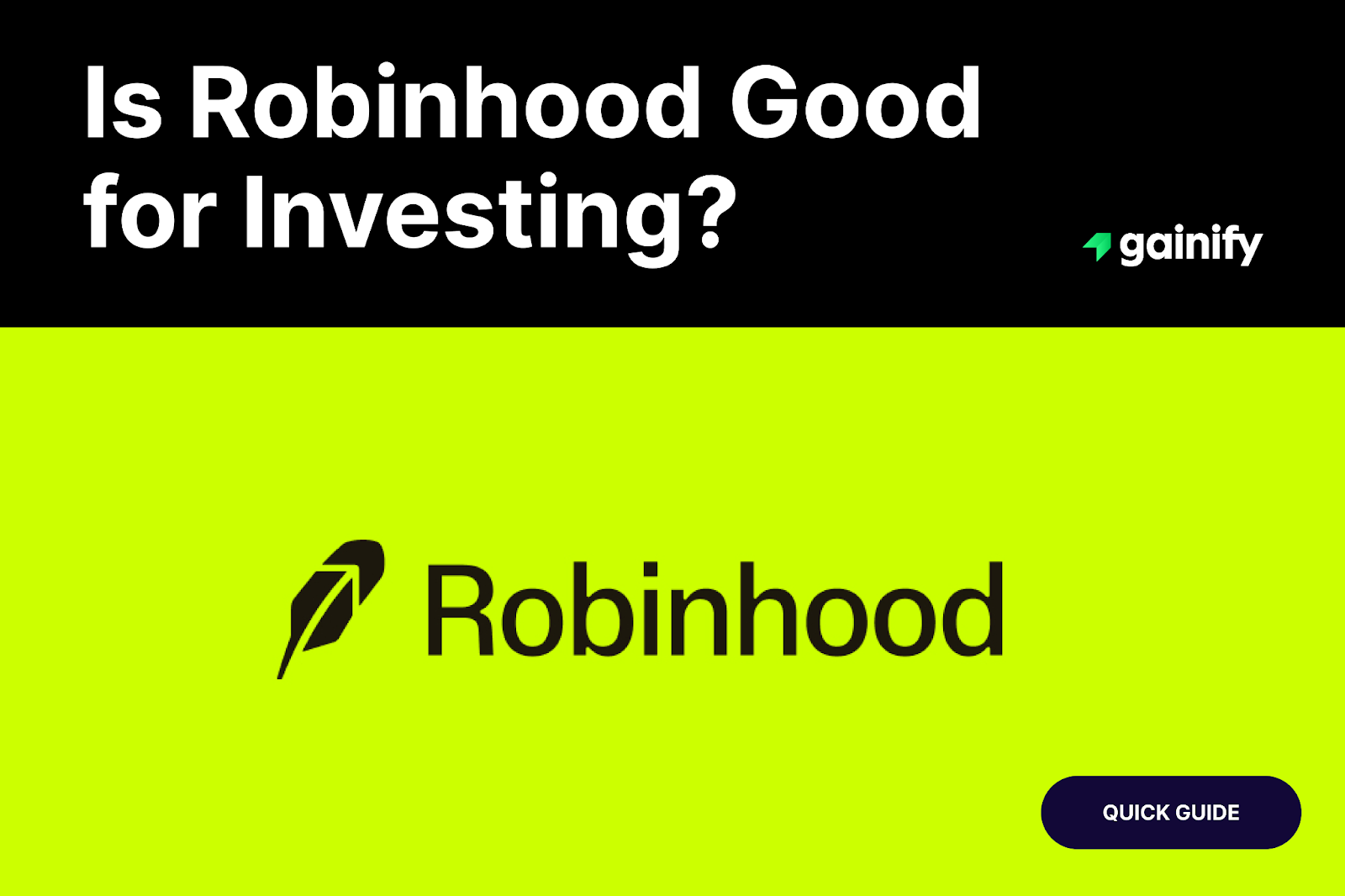In this comprehensive guide, we’ll analyze the top 10 best financial newsletters on the market, from Motley Fool’s various tiers to free options like Morning Brew – examining pricing, markets and industries covered, user experiences, and more.
You’ll discover exactly what you get for your money, what’s missing, and why an entire generation of investors is abandoning the newsletter model for something radically better.
Whether you’re a current newsletter subscriber questioning the value, seeking the best investment newsletters 2025 has to offer, a new investor overwhelmed by options, or exploring alternatives, this guide provides the analysis you need to make an informed decision.
Quick Summary: Top Financial Newsletters at a Glance
Whether you’re seeking AI-powered research tools, expert stock picks, or daily market updates, these financial newsletters and platforms cater to different investment styles and experience levels. From free daily briefings to premium stock recommendations, below you will find the top options to enhance your investing knowledge in 2025.
Best Alternative to Newsletters
Gainify ($7.99/month) – AI-powered research platform covering 25,000+ stocks with institutional data, real-time analysis, and investor tracking tools. Delivers unlimited research instead of limited monthly picks.
Best for Beginners
Morning Brew (Free) – Daily financial news covering market movements, company updates, and economic trends. Perfect for building market knowledge.
Best Premium Newsletter
Motley Fool Stock Advisor ($199/year) – Two monthly stock picks from the Gardner brothers plus “Best Buys Now” list. Long track record since 1993, but aggressive upselling can frustrate.
Best for Value Investors
Value Line Wealth Newsletter ($49/year) – Monthly focused analysis from Value Line’s many years of investment research expertise. Covers financial planning and investment strategies with both print and digital editions. It is the most affordable way to access Value Line’s trusted insights.
Best Free Newsletter
The Average Joe (Free) – Rather than providing stock picks, this newsletter focuses on simplified market and company insights. It covers trending stocks, job reports, and sector analysis.
Sherwood Media’s three newsletter offerings, and The Daily Upside are two more top free financial newsletters you won’t regret signing up for.
Quick Comparison: Which Financial Newsletter Fits Your Needs?
Investor Type | Best Choice | Price | What You Get | Key Limitation |
Active Traders | $96/year | Unlimited real-time research, AI analysis | Not traditional newsletter format | |
Beginners | Morning Brew | Free | Daily market education | No specific stock picks |
Long-term Investors | Stock Advisor | $199/year | 24 picks yearly, proven track record | Monthly picks may be outdated |
Value Seekers | Value Line | $49/year | Monthly analysis, financial planning insights | Less comprehensive than full survey |
Budget-Conscious | The Average Joe | Free | Market trends & insights | Limited analytical depth |
Data & Chart Driven | Sherwood (Chartr) | Free | Data storytelling for quick insights | Limited in depth analytical reports |
The Bottom Line for 2025
You probably don’t need expensive financial newsletters charging $500-$14,000 annually for limited monthly picks. Free newsletters provide market education, budget options offer curated selections, while AI-powered platforms like Gainify deliver institutional-grade research. Choose based on your trading frequency, budget, and whether you want to follow picks or conduct your own research.
Your quick decision framework:
- Trade weekly or more? Skip newsletters entirely – you need real-time tools.
- Trade monthly? Consider budget newsletters ($200-$300) supplemented with research tools.
- Trade quarterly? Premium newsletters might work, but verify their track record first.
- Just learning? Start with free newsletters, then move up to research platforms.
- Want it all? Combine Gainify’s research platform with 1-2 free newsletters for perspectives.
The Problems with Financial Newsletters
While technology has revolutionized how we trade (commission-free, instant execution, mobile apps), many still receive investment advice through monthly investment newsletters.
Moreover, if you’ve been seeking a financial newsletter for niche stock picks, you probably already know that they can be expensive.
Ranging from a few hundred dollars per year (accessible for many retail investors) to many thousands of dollars annually (far too steep for many!).
For example, Motley Fool’s premium “Fool One” service – often marketed as one of the top rated investment newsletters – charges nearly fourteen thousand dollars annually for email-based investment advice.
There’s also another problem consistent across the majority of financial newsletters – it’s that the market moves fast but newsletters land in your inbox once a month (or once per week at best).
By the time the editorial team has researched a stock, compiled their insights into the email newsletter, and then waited for their regular weekly send day – a lot has shifted in the markets.
Other common problems with financial newsletters include:
- Information available free elsewhere
- Aggressive upselling
- Generic advice
But what if there was a better way? What if the best alternatives to Motley Fool and other financial newsletters weren’t other newsletters at all?
What if you could access institutional-grade research on 25,000+ global stocks, powered by AI that actually learns your investment style? What if this cost MUCH less than premium newsletters while delivering real-time insights?
Gainify: The AI-Powered Future of Investment Research
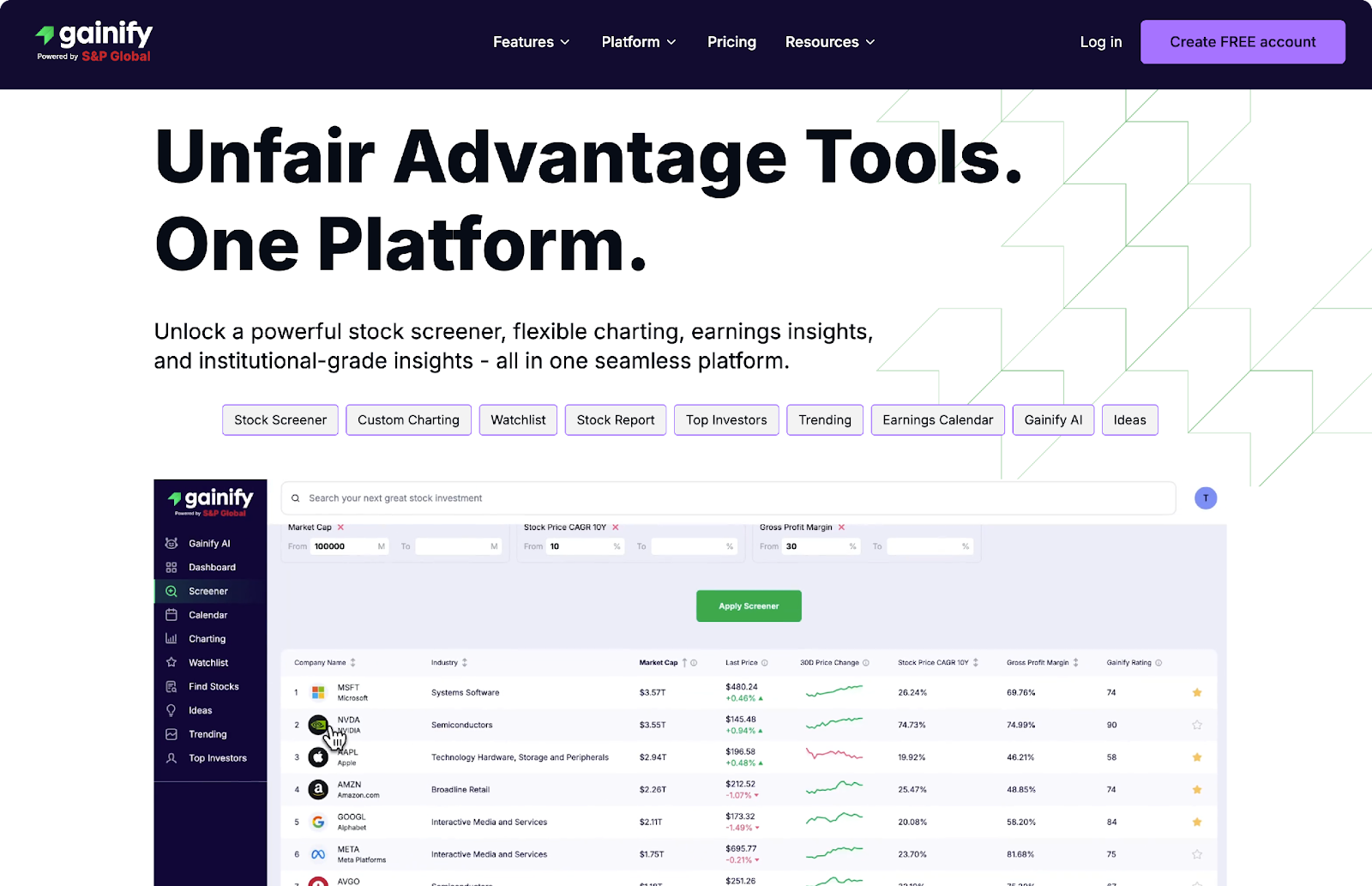
Financial newsletters are not the only way you can uncover top stocks and learn about their fundamentals.
Three trends make 2025 a pivotal year for reconsidering financial newsletters:
- Data democratization: Information once exclusive to institutions is increasingly accessible
- AI integration: Machine learning is transforming investment research
- Cost pressure: With inflation impacting budgets, subscription costs matter more
Today, you can access institutional grade research and analysis on demand – and analyze an unlimited amount of stocks for less than the cost of a monthly newsletter.
Gainify provides automated custom stock screening, custom stock charting, and on-demand AI analysis of any stock, anytime.
If you still want an expert’s opinion on which stocks to watch and buy, just turn to the Trending section for insights into what Congress and others are buying and selling, or Top Investor Tracking to view portfolios of the world’s best such as:
- Robert Vinall (Rv Capital Ag)
- David Tepper (Appaloosa)
- Michael Burry (Scion Asset Management)
- Jim Simons (Renaissance Technologies)
If your trading is real time, and available on your mobile phone anytime you want to place an order – then why is your stock research powered by monthly PDFs in your inbox? You need real time insights, the ability to go beyond select stocks presented to you in newsletters, and to create your own stock research screeners and processes.
Instead of receiving pre-selected stock picks monthly, use Gainify’s AI-powered tools for on-demand research. Gainify covers global markets with institutional-grade data sources, analyzing companies through hundreds of metrics – rather than the typical 10-15 factors that financial newsletters consider.
- Speed: Real-time analysis vs monthly updates
- Personalization: AI adapts to your individual queries
- Coverage: Access to 50+ global markets vs US-only picks
- Data quality: S&P Global institutional data vs basic metrics
- Tools: Stock screener, top investor tracking, earnings calendar
For just $7.99/month, you get (almost) unlimited research on tens of thousands of stocks. Compare that to paying $199 for 24 generic picks.
1: The Motley Fool Newsletter Portfolio
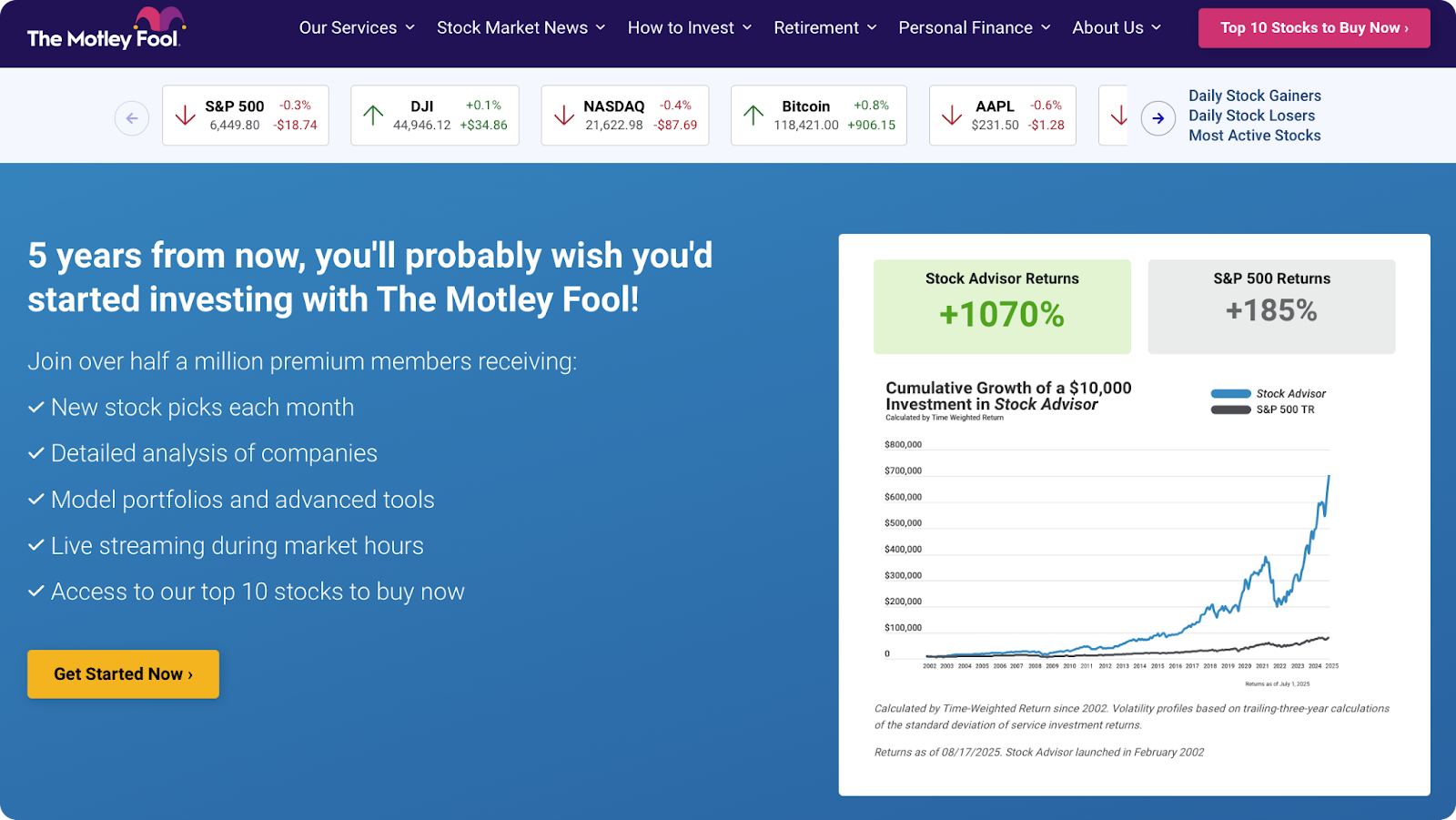
Motley Fool runs a comprehensive portfolio of newsletters. The more you pay, the more insights you get. But it gets expensive fast.
Stock Advisor ($199/year)
With the Stock Advisor subscription, you get two monthly stock picks, one from each Gardner brother (the two Motley Fool founders).
Two recommendations per month is not a lot – but you are also provided a “Best Buys Now” list of 10 stocks selected from past recommendations.
However, beware an endless stream of upselling emails pushing you toward more expensive tiers.
Some users complain that Motley Fool relentlessly attempts to upsell them into more expensive services and tiers – something that can detract from the value of its research.
Epic ($499/year)
Once you’re paying $199 for Stock Advisor, the upselling machine kicks into high gear. Epic positions itself as the “serious investor” upgrade. You’re promised better picks and earlier access.
Instead of monthly updates, you receive weekly emails. So rather than just 24 stocks per year you’re presented with roughly 50 stock picks.
Fool One ($13,999/year)
Fool One is one of the most (if not the most!) expensive financial newsletters out there. If you can even think of paying for this then you’ve likely already got a million dollar portfolio.
With this elite tier subscription you’re provided every Motley Fool offering along with daily trade alerts, direct analyst access, concierge support, and portfolio reviews.
For context, $13,999 could max out your IRA contributions for two years, or purchase access to Gainify’s platform for 140+ years.
2: Seeking Alpha
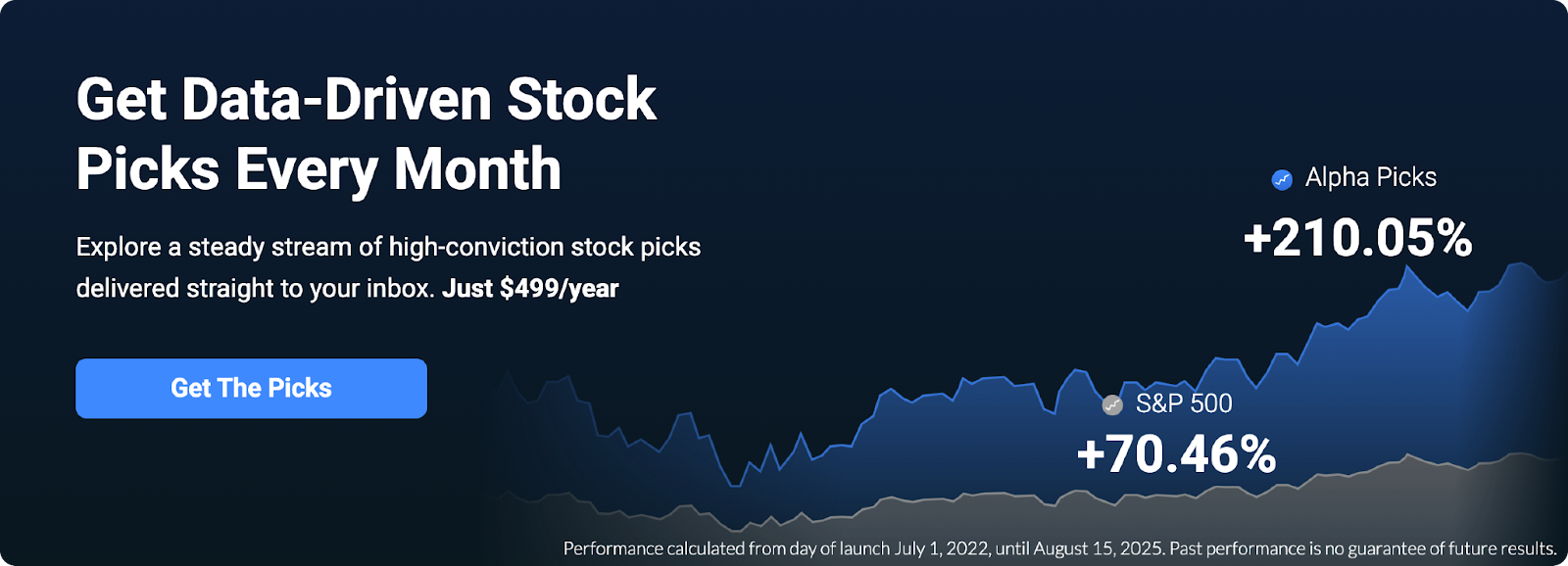
Seeking Alpha is one of the world’s largest sources of crowd sourced financial and investment insights. Its internal editorial team and regular website users create thousands of articles daily.
But this huge scale of publishing comes with its drawbacks. You cannot possibly read and analyze all the (often contradicting) opinions produced for the website.
Quality also varies widely. The internal editorial team maintains a more consistent style and level of quality. But individual contributors can write whatever they like about anything they want to write about – some are great writers, others not so much.
It’s understandable if you would find this approach to investment research and advice overwhelming.
Alpha Picks by Seeking Alpha
Seeking Alpha does make things easier for you with Alpha Picks – providing 2 vetted stock picks to buy and hold each month. When ratings change, you’ll be updated with a sell recommendation.
A quick rundown of what to expect from Alpha Picks:
- Covers a range of industries
- Does not suit dividend investors
- Only for a buy and hold investing strategy
But Alpha Picks will cost you $499 per year. Unless your portfolio is very large, this $499 will eat into your profits significantly – so Alpha Picks is not for everyone.
Another drawback is that you will need to invest in all picks to get full value (biggest winners make up the majority of returns so you cannot miss them but don’t know in advance which will win big and which will lose money.)
To invest in all 24 picks you need a sizeable amount of investible capital.
Even if you do have a large portfolio and can cover the $499 cost – 2 stock picks per month may be too little to help you build the best possible portfolio for your goals and strategy.
You’ll certainly need a stock research platform like Gainify in addition to your newsletter subscription – without it you won’t be able to research the volume of stocks required to find the true best picks for your portfolio.
3: MarketWatch ($260/year)

MarketWatch isn’t really a financial newsletter in the true sense of the meaning. It’s really a financial news website with a paywall.
For $260 annually, you’re essentially paying to remove ads and access unlimited articles beyond the five free monthly ones.
MarketWatch is typically included in bundle deals along with Barrons and WSJ – so you end up paying for multiple services that strongly overlap, none of which you fully utilize.
The platform has an abysmal Trustpilot rating of just 1.4/5 stars. Some users complain MarketWatch is unsuitable for investing purposes, unreliable, and voice concerns about conflicts of interest.
4: Barron’s ($259.87/year)

Since 1921, Barron’s has represented the gold standard in financial journalism. By subscribing, you gain access to weekend deep dives and institutional-quality analysis.
However, if you trade frequently (every few weeks or more), you might question if Barron’s subscription is worth it when markets move faster than weekly analysis. By the time Barron’s thoughtful analysis reaches you Saturday morning, you might be late to the party. Markets move fast – Barrons is best for a long term buy and hold strategy.
5: Morningstar Investor ($249/year)
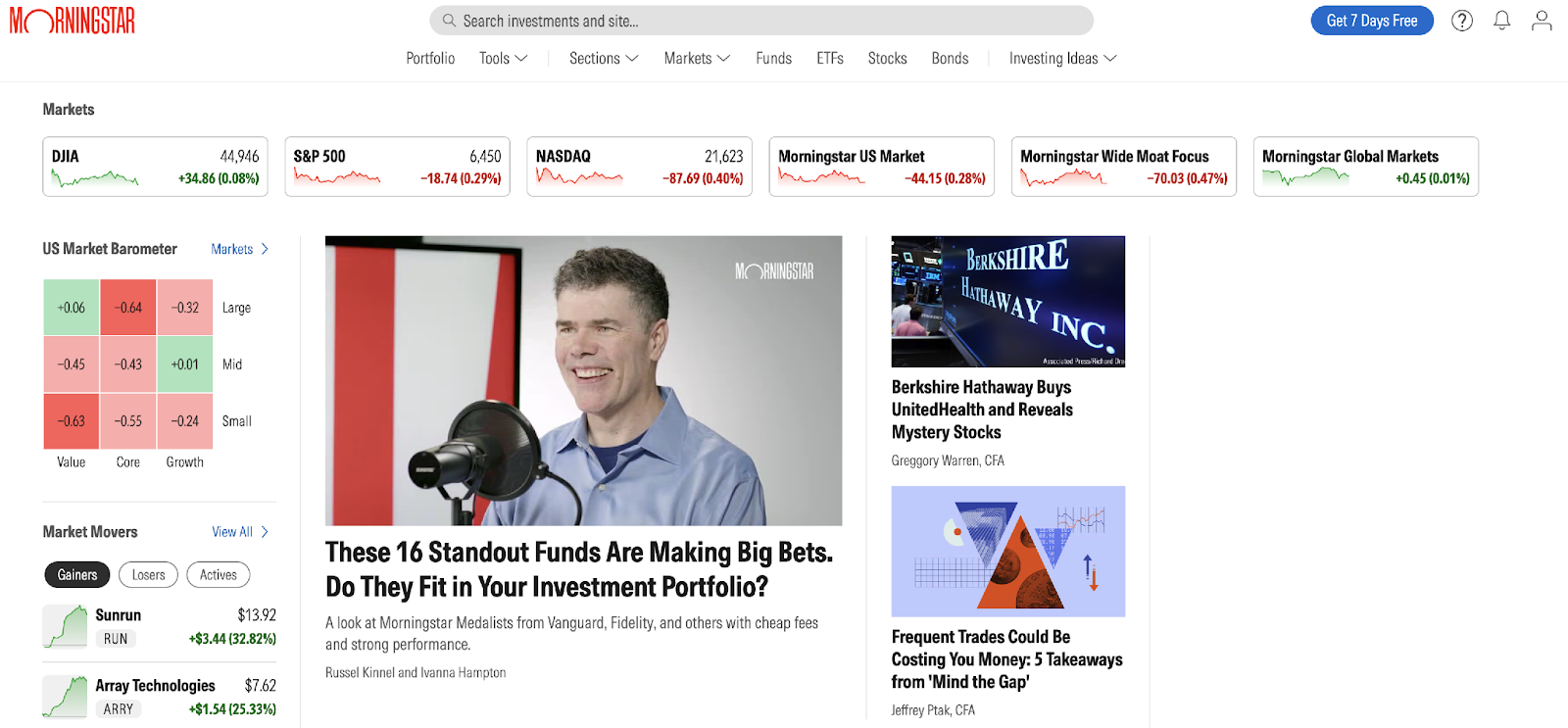
With Morningstar you’ll benefit from fundamental analysis, fair value estimates based on discounted cash flow models, and “economic moat” ratings assigned to companies.
All very helpful information when making investing decisions.
It is best suited for a value investing buy-and-hold approach – so if you’re heavily invested in growth and emerging technology sectors then Marketwatch’s suggestions may not suit your investing goals.
6: Kiplinger Letter ($117/year)
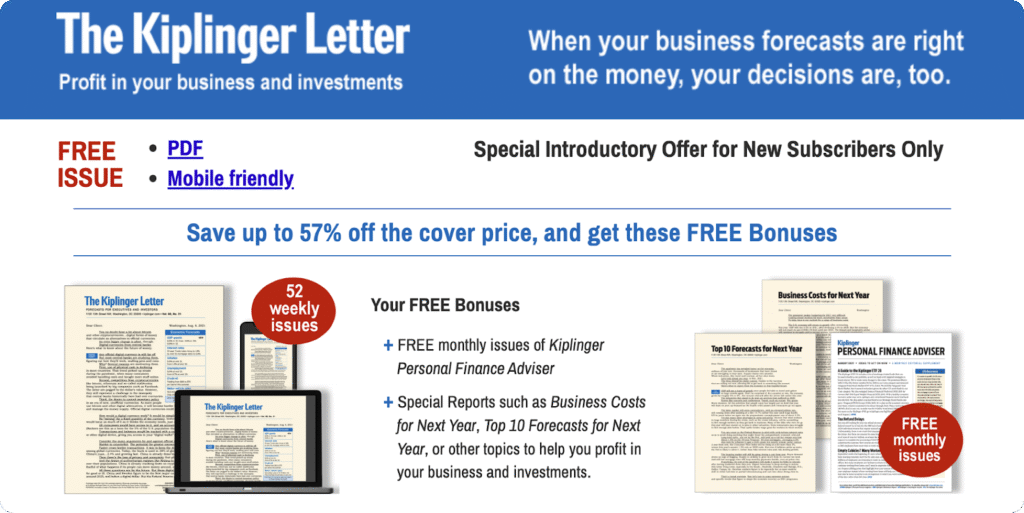
Kiplinger takes a slightly different approach to investing news & research. Rather than reports on fundamentals or stock charts, you’ll gain access to valuable economic forecasting and policy analysis from a Washington perspective.
For $117 annually, you receive bi-weekly updates on legislative developments, regulatory changes, and economic trends that might affect your investments.
When the Fed signals policy changes, they decode what it means for different sectors. When Congress debates tax reform, Kiplinger explains how it affects your portfolio.
If you want broad analysis and a breather from all the ‘hot stock picks’ newsletters out there, then Kiplinger may be for you.
7: Value Line ($49–$795/year)

Value Line – a newsletter investors rely on for its concise and consistent analysis – offers both free and paid options.
Market Focus – Value Line’s free weekly email newsletter – provides you with insights into individual stocks and industries within the Dow 30.
For more frequent updates you can subscribe to Stock Market Today, another free email newsletter providing a daily market outlook.
Paid Value Line services include:
- The Value Line Investment Survey®: For $598 per year you get access to concise single page analyses for large, mid and small-cap stocks in over 90 industries.
- The Value Line Investment Survey® – Small & Mid-Cap: If you’re not interested in large cap stocks, for $249 annually you can access information limited to ~1800 small & mid cap stocks.
- The Value Line Investment Survey® – Small Cap Investor: If your investing strategy centers around small cap stocks, you can unlock concise single-page analyses for 1800 small cap stocks for $225.
If the above options are outside your price range, then the “The Value Line INFORMATION YOU SHOULD KNOW – Wealth Newsletter” can be had for just $49 per year.
All in all ‘Value Line’ has 12 different “Investment Survey” newsletter offerings tailored to different investing strategies.
There are also another 12 “Value Line Select” newsletters focused on providing select stock picks across the following strategies:
- Dividend and growth investing
- Climate change investing
- ETFs
- M&A
Prices range from $198 to $795.
With so many offerings (24!) available it will certainly be difficult to choose which one you wish to subscribe to. But after some analysis and comparison, you’ll likely find something that suits your goals and needs.
8: Morning Brew

Morning Brew is a free newsletter – known as one of the best and most popular in the finance news space.
You’ll be able to stay up to date with:
- Banking news
- Company news and insights
- Fed and interest rate updates
Latest topics include pieces about why the Vegas strip is empty, inflation, how AI is propping up the economy, decline in alcohol consumption, and more.
While you won’t find specific stock picks, you will uncover valuable information about market and business trends.
9: The Average Joe
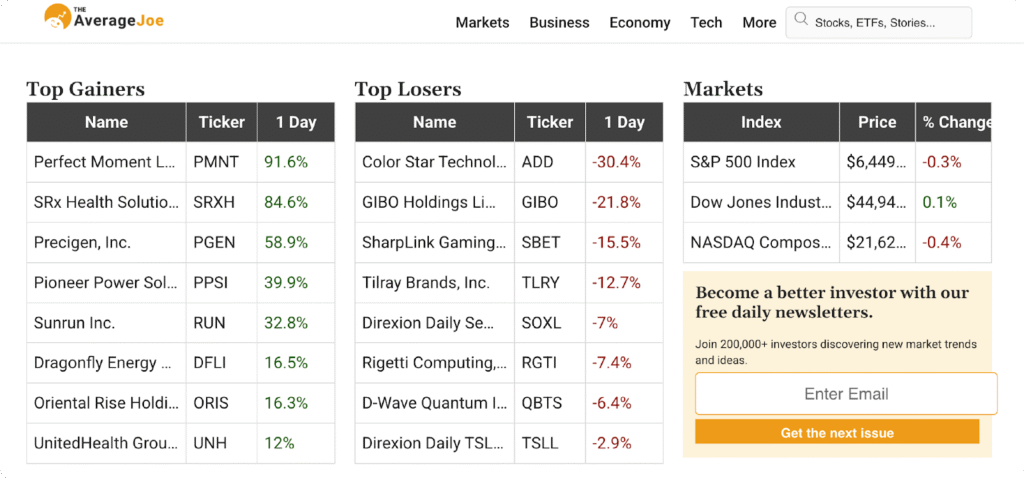
The Average Joe is a free investing newsletter read by over 200,000 investors. It’s a great choice if you’re exploring financial newsletters to see if they are a valuable part of your stock research process.
Latest editions cover:
- Rivian
- Nuuly
- Jobs reports
- Gaming companies
Similar to Morning Brew, you won’t find value investing insights, fundamental analysis, or analyst estimates – the newsletter is mostly focused on business and finance news.
10: The Financial Times ($540 annually)
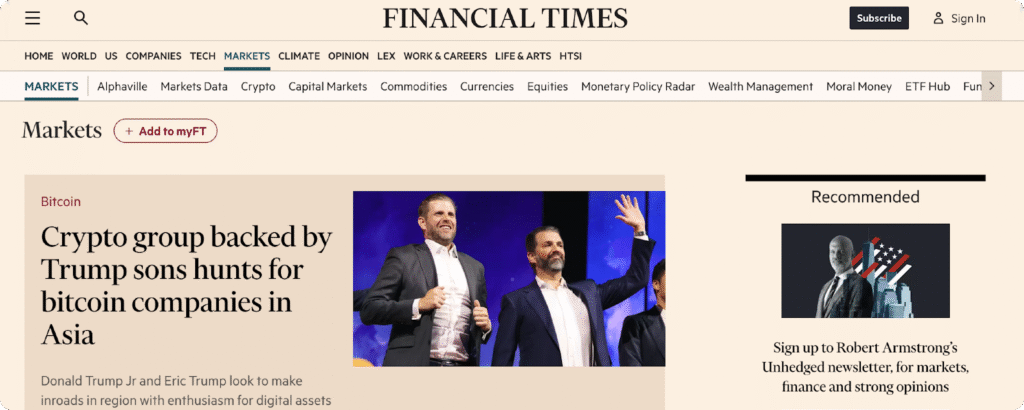
The basic FT Digital Edition ($140/year) provides access to the digitized newspaper.
The Standard Digital subscription ($540/year) gives you access to the flagship FirstFT daily briefing, plus:
- Over 20 curated newsletters covering everything from markets to technology
- The ability to follow specific topics and set alerts through myFT
If you’re an international investor you will appreciate FT’s global perspective. While most financial publications focus on their home markets, the FT’s worldwide bureau network provides truly international analysis.
11: The Daily Upside

The Daily Upside is completely free to all subscribers. It generates its revenue through advertising and sponsorships – not from subscription fees.
Founded in 2019 by former Guggenheim Partners banker Patrick Trousdale, the newsletter has grown to over 1 million subscribers.
You’ll get daily emails Monday through Friday before 9 AM ET.
If you’re seeking business and finance news with distinctive wit and humor, and writing that makes complex topics accessible – The Daily Upside is a good option for you.
12: Sherwood Media
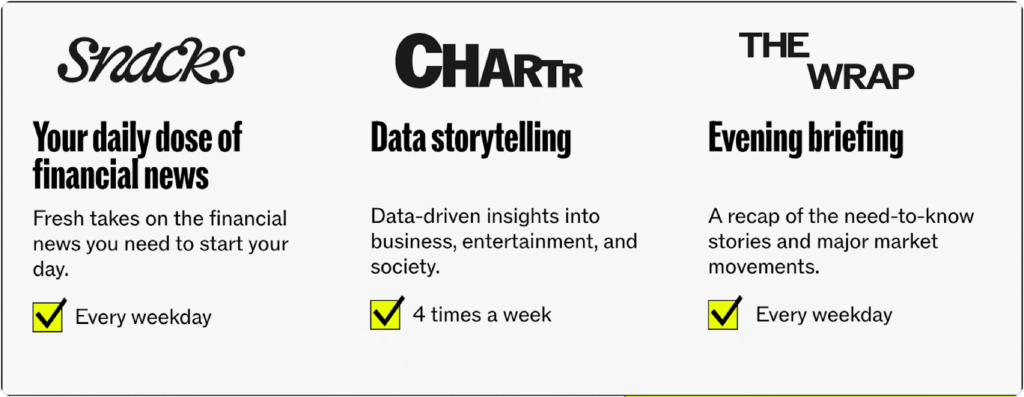
Sherwood Media is Robinhood’s media subsidiary, and operates three newsletters all offered completely free.
- Snacks Daily: Publishes business days with a weekly summary Mondays at 6:30 AM ET.
- Chartr: Publishes four times weekly with data visualizations covering business, technology, entertainment, and society. Content emphasizes visual storytelling through charts and infographics.
- The Wrap: Provides daily end-of-day market recaps in a five-minute format, complementing the morning Snacks newsletter (which sends before market open).
Sherwood targets the “generation lost between business broadsheets and short-form social media.” If that sounds like you, give Sherwood a try!
Other notable mentions
- Wall Street Journal ($480/year)
- Reuters ($45/year)
- Bloomberg tech newsletters ($143.88/year)
How to Evaluate Financial Newsletters
Before you hand over your credit card for that “limited-time offer” on a financial newsletter, you should know that the financial newsletter industry thrives on impulse decisions.
Sales pages and newsletter editions themselves push urgency, display countdown timers, and emphasize what you’ll miss rather than what you’ll actually receive – all in an attempt to circumvent your critical thinking.
Take time to properly evaluate whether financial newsletters are worth it for your situation before subscribing – it can save you thousands of dollars and plenty of frustration.
FOMO
Marketers understand that FOMO (fear of missing out) can make you act impulsively.
Most commonly you will encounter FOMO triggers in the form of:
- Limited spots left: “only 100 spots remaining”
- Countdown timers: “Closes at midnight” or “Closes in 2 hrs 15 mins” (the timers are artificial and reset for new users)
Manufactured urgency like this short-circuits your typical buying process, prevents careful evaluation, and pushes you to buy before thinking.
The Upsell Architecture
Many financial newsletters use aggressive upselling to get more money out of you. The free newsletter you signed up for is likely just the entry point for a very long and aggressive marketing funnel.
Once you’ve consumed free content for a few weeks, the emails shift toward promoting their basic service.
But if you sign up to the basic tier you’ll find content at this level is deliberately incomplete, constantly referencing better picks available at higher tiers.
Then the real marketing begins – attempting to upsell you to higher and higher tiers. Naturally, products are becoming increasingly expensive.
Some newsletters seem to do more upselling than actual stock research.
Beware that when you do sign up for a newsletter – especially a free or low priced one – you should expect to be sent a significant amount of marketing materials.
Track Record Manipulation
Avoid newsletters that only focus on their biggest winners.
Two common “marketing” tricks are cherry picking timeframes or stocks. For example, taking a timeframe from after the dot com bust to before the global financial crisis – basically, avoiding large downturns.
Most commonly you will see a huge focus on big winners like NVIDIA or Tesla, while the rest of their stock picks may have lost big and put your portfolio in the red.
The Cancellation Maze
Some financial newsletter subscriptions are notorious for being very hard to cancel. Their goal is to make it as difficult and uncomfortable as possible for you if you decide to stop paying.
When reviewing financial newsletters, pay attention to money back periods, cancellation terms and conditions, etc.
Keep your eye out for warning signs like:
- Phone-only cancellation during limited business hours
- Email only cancellation requests
This is to force you to engage with their retention specialists, who will do all they can to convince you not to cancel.
You should be able to cancel your subscription online anytime, with an easy to find cancellation page.
If you’re not sure about whether you will be able to cancel easily or not, you can set up a temporary digital bank card just for that subscription. If the company makes it difficult to cancel, simply block that card and move on.
Conclusion: Don’t Limit Yourself to Financial Newsletters
When stock research and real-time data were less democratized, it made sense to pay for expensive stock-picking newsletters. The alternatives were clunky, expensive research platforms with their own limitations – the truly valuable data and research capabilities remained exclusive to institutional investors. Financial newsletters filled a genuine gap, providing curated insights that individual investors couldn’t access otherwise.
Today, retail investors have access to institutional-grade data, AI-powered analysis, and research capabilities for very accessible prices. The same S&P Global data that powers Wall Street decisions, the ability to track congressional trades in real-time, and AI that analyzes stocks in an instant – are all available to you as a retail investor.
You’re no longer dependent on someone else’s monthly stock picks arriving days or weeks after the opportunity emerged.
You have the tools to discover opportunities yourself, validate ideas instantly, and act on real-time information.
The technology exists. The data is accessible. You’re not limited to someone else’s analysis.
That being said, financial newsletters can still be a valuable supplement to your own research. You may be introduced to stocks or market conditions that you’d previously missed, or gain a valuable additional perspective you may not have considered.
Use financial newsletters as an additional “nice to have” on top of your core “must have” stock research platform like Gainify – and only after doing considerable research to determine which financial newsletter is best for your specific needs.
Best Alternatives to Traditional Newsletters
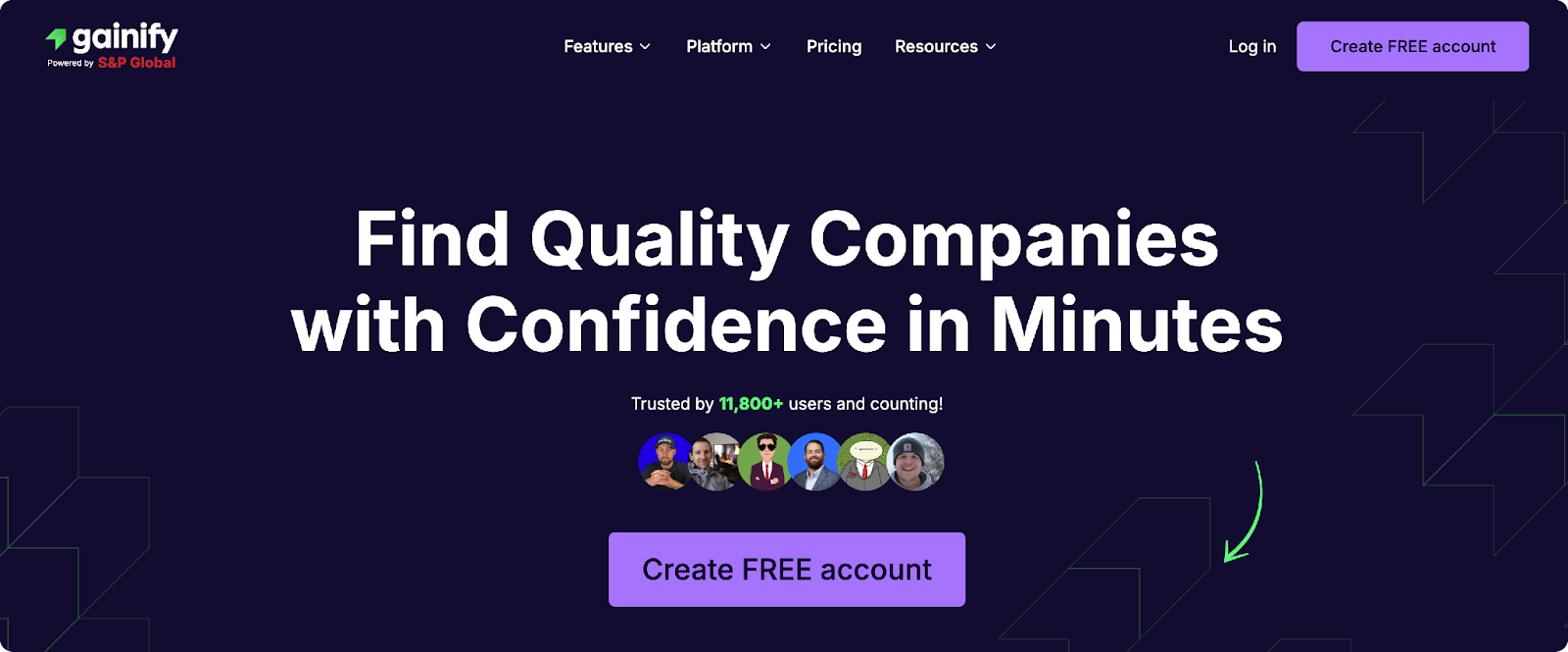
While newsletters send you monthly picks, Gainify delivers professional-grade research tools at a fraction of the cost. Each feature replaces what newsletters try to provide – but with real-time data, unlimited scope, and AI-powered insights.
AI Research Assistant: Your 24/7 Investment Analyst
Forget waiting weeks for newsletter analysis on a handful of stocks. Gainify’s AI-powered insights cover 25,000+ stocks using S&P Global data, delivering answers in seconds about valuations, growth prospects, competitive positioning, or sector trends. Whether evaluating Microsoft’s AI strategy or comparing semiconductor valuations, you’re getting institutional-grade research on demand – not monthly emails with limited coverage.
Top Investor Tracking: Follow Real Money, Not Opinions
Why settle for newsletter editors’ theoretical picks with cherry-picked track records when you can see what legendary investors actually buy and sell? Track the real portfolios of Michael Burry, David Tepper, Jim Simons, and other investing legends in real-time. Monitor congressional trades and insider buying as they happen. These aren’t predictions – they’re actual positions backed by billions in capital.
Stock Screener: Find Your Own Winners
Those 2-4 generic monthly picks chosen for the average subscriber can’t match the power of screening 25,000+ global stocks yourself. With 500+ criteria including forward estimates, valuation multiples with 10-year history, and Gainify’s proprietary ratings, you can build screens for value plays, growth stocks, dividend aristocrats, or any strategy that fits your goals. Discover opportunities newsletters never even consider.
Earnings Intelligence: Real-Time Market Reactions
Outdated quarterly commentary arriving weeks after earnings becomes irrelevant when you have AI-powered analysis within hours of release. Track estimate revisions, guidance changes, and management sentiment as markets react. Understanding why stocks move on earnings – not just that they moved – means accessing historical beat/miss patterns and forward-looking analyst revisions instantly.
Gainify Rating: Objective Analysis, Not Subjective Opinions
Newsletter writers bring personal opinions and biased recommendations, but Gainify’s proprietary 100-point scoring system analyzes stocks objectively across five dimensions: Outlook, Valuation, Health, Performance, and Momentum. Each score draws from 20+ factors, providing data-driven insights you can trust. Compare any stock’s rating to its peers and track rating changes over time.
Smart Stock Ideas: Dynamic Lists That Update Daily
Static “best stocks for 2025” lists age poorly the moment markets shift. Gainify’s curated collections – top AI stocks, quantum computing plays, dividend champions – update based on actual market conditions. These dynamic watchlists reflect current opportunities across emerging themes and proven strategies, not annual predictions frozen in time.
Analyst Estimates Database: See the Future, Not the Past
While newsletters offer commentary on last quarter’s results, you need forward-looking intelligence. Access the world’s largest database of analyst estimates for retail investors, with consensus forecasts for revenue, earnings, and cash flow extending three years ahead. Tracking estimate revisions reveals improving or deteriorating fundamentals before they show up in any newsletter recommendation.
Frequently Asked Questions
Are financial newsletters worth it?
Traditional financial newsletters struggle to justify their cost in 2025. Premium services charging hundreds to thousands annually for limited monthly picks can’t match the value of AI-powered platforms offering unlimited research for under $10 monthly. Unless you specifically want curated editorial opinions rather than comprehensive research tools, modern alternatives deliver better ROI.
What’s the best financial newsletter for beginners?
Free options like Morning Brew and The Average Joe provide market news without the commitment. However, beginners benefit more from educational platforms with research tools than passive newsletter consumption. Learning to analyze stocks yourself with proper tools builds lasting investment skills that monthly stock picks never will.
How much should I pay for investment advice?
Quality investment research shouldn’t break your budget. While premium newsletters charge $500-$14,000 annually, comprehensive AI-powered platforms cost under $100 yearly. If a newsletter costs more than 0.5% of your portfolio annually, the fees likely outweigh potential returns – especially for portfolios under $100,000.
Can I trust stock picks from newsletters?
Newsletter track records often highlight winners while downplaying losers. Without transparency about all recommendations and real portfolio performance, it’s impossible to verify actual returns. Additionally, by the time monthly picks reach your inbox, institutional investors have already acted on the same information, reducing your potential gains.
Why are financial newsletters so expensive?
Newsletter pricing reflects legacy business models, not actual value delivered. High prices fund aggressive marketing campaigns, sales teams, and multiple upsell tiers rather than better research. When newsletters charge thousands annually while AI platforms offer superior tools for a fraction of the cost, you’re paying for the business model, not the insights.
What’s replacing traditional investment newsletters?
AI-powered research platforms represent the future of investment analysis. Instead of waiting for monthly picks, investors access real-time analysis, custom screening, and institutional data on-demand. Tools that track congressional trades, monitor top investors, and analyze global markets provide actionable intelligence newsletters can’t match.
What are the best financial newsletters for beginners?
For beginners, free newsletters like Morning Brew and The Average Joe explain market movements in plain language without overwhelming technical analysis. However, learning to research stocks yourself often beats following picks you don’t understand. Platforms like Gainify offer educational tools alongside analysis for just $7.99 monthly – far less than premium newsletters charging hundreds. The best beginner newsletters balance education with actionable insights while teaching you to evaluate stocks independently.
Are paid investment newsletters worth it?
Most paid investment newsletters struggle to justify their cost in 2025. Premium services charge $199-$13,999 annually for limited monthly picks, while AI-powered platforms offer unlimited research for under $100 yearly. Services like Motley Fool’s Epic ($499) or Seeking Alpha’s Alpha Picks ($499) provide curated selections, but you’re paying for curation, not performance. Unless you specifically value editorial opinions over comprehensive research capabilities, modern AI alternatives deliver superior ROI.
Which financial newsletter has the best track record?
Determining consistent outperformers is challenging since most newsletters cherry-pick their best results for marketing. Motley Fool’s Stock Advisor claims impressive returns, but these often exclude timing and position sizing. Value Line offers more transparent performance tracking with decades of data. However, newsletters that excel in specific market conditions often underperform when trends shift. By the time monthly picks reach your inbox, institutional investors have already acted, diminishing potential returns.
How can AI improve my stock research?
AI transforms stock research by analyzing hundreds of metrics simultaneously across thousands of stocks – something impossible for human analysts. Platforms like Gainify use AI to provide instant analysis of any stock, custom screening based on your criteria, and pattern recognition across global markets. Instead of waiting for a newsletter’s monthly picks, you get personalized insights on-demand, adapted to your investment style.
What data do modern research platforms provide that newsletters don’t?
Modern platforms offer institutional-grade data from providers like S&P Global, covering 25,000+ stocks across 50+ global markets. You get real-time earnings calendars, congressional trading data, top investor portfolio tracking, and comprehensive fundamental analysis. This breadth and depth of data simply isn’t available through traditional newsletters limited to a handful of monthly picks.
Can I track what successful investors are buying?
Yes – platforms like Gainify let you monitor portfolios of legendary investors like Michael Burry, David Tepper, and Jim Simons in real-time. You see exactly what they’re buying and selling, when they make moves, and how their strategies evolve. This transparency beats waiting for a newsletter editor’s interpretation of market moves.
How do I research international stocks?
While most newsletters focus exclusively on US markets, modern platforms provide comprehensive coverage of global exchanges. Gainify covers 50+ international markets with the same depth of analysis as US stocks. You can screen European dividend aristocrats, analyze Asian growth stocks, or explore emerging market opportunities – all with institutional-quality data.
What if I want expert opinions, not just data?
Modern platforms combine both. Gainify’s Trending section shows what Congress members and top investors are actively trading – real skin-in-the-game insights rather than theoretical newsletter picks. You get expert actions, not just opinions, plus AI analysis that explains the “why” behind market moves.
Should I cancel my financial newsletter subscription?
If you’re paying hundreds annually for generic monthly picks while actively trading, you’re likely overpaying for outdated information. Modern investors need real-time tools, not delayed newsletters. However, if you genuinely value editorial perspective over comprehensive research capabilities, selective newsletter subscriptions might still serve a purpose.
How do I evaluate a financial newsletter before subscribing?
Check cancellation policies first – legitimate services allow easy online cancellation. Verify performance claims by requesting complete track records, not just highlights. Watch for aggressive upselling and artificial urgency tactics.
Is AI-powered stock analysis reliable?
AI-powered analysis using institutional data sources provides more consistent, comprehensive insights than human analysts reviewing limited metrics. Platforms like Gainify analyze hundreds of data points per stock, identify patterns humans might miss, and update in real-time as markets move. The key is ensuring the AI uses quality data sources – which is why platforms using S&P Global data deliver institutional-grade reliability.

